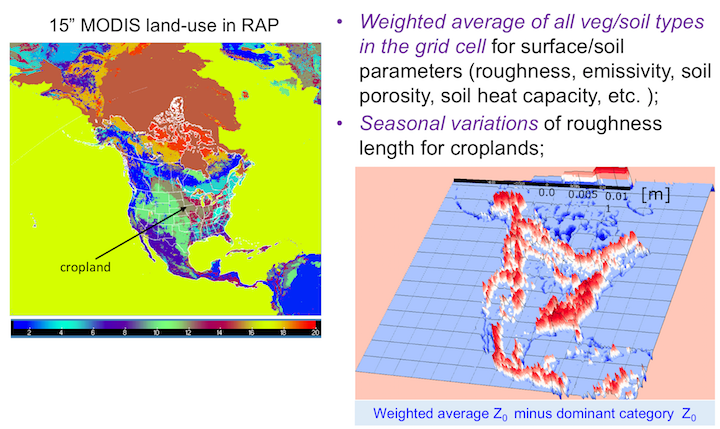The land surface model (LSM) was originally developed as part of the NOAA Rapid Update Cycle (RUC) model development effort; with ongoing modifications, it is now used as an option for the WRF community model. The RUC model and its WRF-based NOAA successor, the Rapid Refresh (RAP) and High-Resolution Rapid Refresh (HRRR), are hourly updated and have an emphasis on short-range, near-surface forecasts including aviation-impact variables and pre-convective environment. Therefore, coupling to this LSM (hereafter the RUC LSM) has been critical to provide more accurate lower boundary conditions.
The RUC LSM became operational at the NOAA/National Centers for Environmental Prediction (NCEP) first, as part of the RUC from 1998–2012, and then as part of the RAP from 2012 through the present and as part of HRRR from 2014 through the present. The simple treatments of basic land surface processes in the RUC LSM (Smirnova et al. 2016 [179] ) have proven to be physically robust and capable of realistically representing the evolution of soil moisture, soil temperature, and snow in cycled models. Extension of the RAP domain to encompass all of North America and adjacent high-latitude ocean areas necessitated further development of the RUC LSM for application in the tundra permafrost regions and over Arctic sea ice (Smirnova et al. 2000 [178]). Other modifications include refinements in the snow model and a more accurate specification of albedo, roughness length, and other surface properties. These recent modifications in the RUC LSM are described and evaluated in Smirnova et al. 2016 [179] .
The parameterizations in the RUC LSM describe complicated atmosphere–land surface interactions in an intentionally simplified fashion to avoid excessive sensitivity to multiple uncertain surface parameters. Nevertheless, the RUC LSM, when coupled with the hourly-assimilating atmospheric model, demonstrated over years of ongoing cycling (Benjamin et al. 2004a,b [22] [23] ; Berbery et al. 1999 [26]) that it can produce a realistic evolution of hydrologic and time-varying soil fields (i.e., soil moisture and temperature) that cannot be directly observed over large areas, as well as the evolution of snow cover on the ground surface. This result is possible only if the soil–vegetation–snow component of the coupled model, constrained only by atmospheric boundary conditions and the specification of surface characteristics, has sufficient skill to avoid long-term drift.
International projects for intercomparison of land surface and snow parameterization schemes were essential in providing the testing environment and afforded an excellent opportunity to evaluate the RUC LSM with different land use and soil types and within a variety of climates. The RUC LSM was included in phase 2(d) of the Project for the Intercomparison of Land Surface Prediction Schemes [PILPS-2(d)], in which tested models performed 18-yr simulations of the land surface state for the Valdai site in Russia (Schlosser et al. 1997 [171] ; Slater et al. 2001 [176] ; Luo et al. 2003 [126] ). The RUC LSM was also tested during the Snow Models Intercomparison Project (SnowMIP, SnowMIP2, ESM-SnowMIP), with emphasis on snow parameterizations for both grassland and forest locations in different parts of the world (Etchevers et al. 2002, 2004 [192] [58]; Essery et al. 2009 [56] ; Rutter et al. 2009 [167] , Krinner et al. 2018 [111] ). The analysis of RUC LSM performance over 10 reference sites in ESM-SnowMIP rated it on the 5th place among the 26 participating models. The results were published in Menard et al.(2021) [134] and Essery et al. (2020) [57]. RUC LSM received high rankings in ESM-SnowMIP experiement in terms of multi-year snow cover and surface temperature simulations for several sites located in different parts of the world (Menard et al.2021 [134]).
RUC LSM is used in several weather prediction models around the world (Austria, New Zealand, Switzerland, RAP/HRRR in US). Recent RUC LSM implementation in the high-resolution model in the Swiss Alps led to some small modifications and adjustments to the snow model. These adjustments will be available in the next CCPP public release.
Coupling of the RUC LSM to physically-based stochastic snow model (He et al.(2021) [168]) will be implemented in the next public release.
The sensitivity of surface fluxes and turbine-height winds to the RUC LSM parameters has been explored by Geng Xia, NREL. This study will determine the uncertainty range for the selected parameters in the RUC LSM and will be described in the journal paper.

ice which solves heat diffusion in sea ice and allows evolving snow cover on top of sea ice
Snow forms additional two layers on top of soil in RUC LSM

\[ \rho_{fr}=\rho_{sn}*\alpha_{sn}+\rho_{gr}*\alpha_{gr}+\rho_{ice}*\alpha_{ice} \]

snow accumulation with variable density is provided as an additional product in the model guidance. Figure 4 shows one example of this product from the 23-h HRRR forecast for snowstorm on 29 Dec 2015. This product is in the middle panel. The panel on the left uses traditional 10:1 ratio, and the right panel is oberved snow accumulation. We can see that the new product in the middle here has a better, further north location of maximum snow accumulation, and high ammounts of snow in the product with 10:1 ratio are trimmed in central and southern Iowa where both observed and model precipitation had a high content of sleet. There is even larger improvement in the Chicago area, where observed and model precipitation were almost totally sleet.
flag_cice = .false. (uncoupled sea ice model)showfallac is replaced with snowfallac_ice